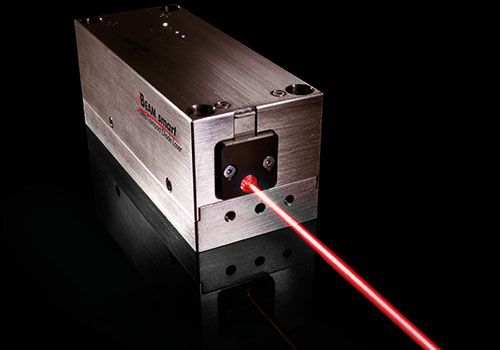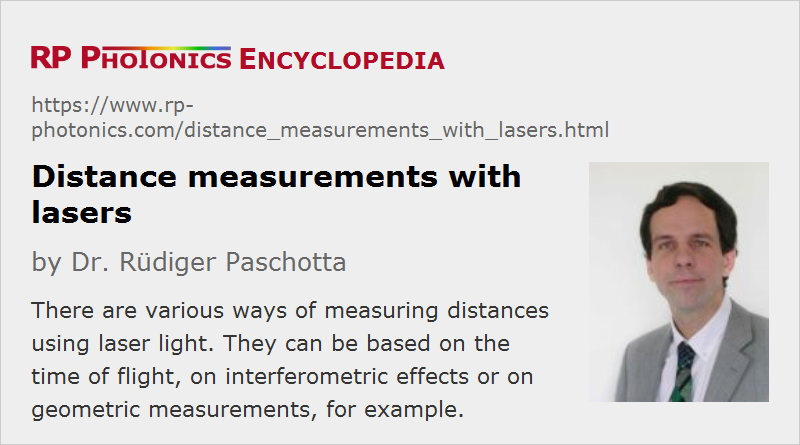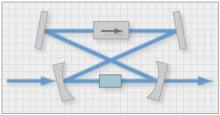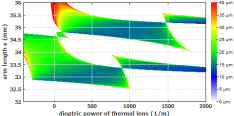Distance Measurements with Lasers
Definition: measurements of distances using laser light
More specific terms: phase shift method for distance measurements, time-of-flight measurements, triangulation
German: Distanzmessung mit Lasern, Laser-Entfernungsmessung
Categories: optical metrology, methods
How to cite the article; suggest additional literature
Author: Dr. Rüdiger Paschotta
Lasers can be used in various ways to measure distances or displacements without physical contact. In fact they allow for the most sensitive and precise length measurements, for extremely fast recordings (sometimes with a bandwidth of many megahertz), and for the largest measurement ranges, even though these qualities are usually not combined by a single technique. Depending on the specific demands, very different technical approaches can be appropriate. They find a wide range of applications, for example in architecture, inspection of fabrication halls, criminal scene investigation (CSI), and in the military.
Techniques for Distance Measurements
Some of the most important techniques used for laser distance meters are as follows:
- Triangulation is a geometric method, useful for distances in the range of ≈ 1 mm to many kilometers.
- Time-of-flight measurements (or pulse measurements) are based on measuring the time of flight of a laser pulse from the measurement device to some target and back again. That method is implemented in various kinds of laser rangefinders. Typical accuracies of simple devices for short distances are a few millimeters or centimeters.
- The phase shift method uses an intensity-modulated laser beam.
This principle is also used by some laser rangefinders.
One measures the phase shift of an intensity modulation which is related to the time of flight.
Compared with interferometric techniques, its accuracy is lower, but it allows unambiguous measurements over larger distances and is more suitable for targets with diffuse reflection.
Note that the phase shift technique is sometimes also called a time-of-flight technique, as the phase shift is proportional to the time of flight, but the term is more suitable for methods as described above where the time of flight of a light pulse is measured. - For small distances, one sometimes uses ultrasonic time-of-flight methods, and the device may contain a laser pointer just for getting the right direction, but not for the distance measurement itself.
- Frequency modulation methods involve frequency-modulated laser beams, for example with a repetitive linear frequency ramp. The distance to be measured can be translated into a frequency offset, which may be measured via a beat note of the sent-out and received beam.
- Interferometers allow for distance measurements with an accuracy which is far better than the wavelength of the light used.
Suppliers
The RP Photonics Buyer's Guide contains 12 suppliers for distance measurements with lasers. Among them:


TOPTICA Photonics
Laser rangefinders can be used to monitor or measure distances or object lengths. They can also provide positional locations over long distances, e.g. several kilometers, without physically touching the observed object. The laser range finders are regularly used in geodesy, sports, hunting or military. Usually, the distances are measured with accuracies of up to a millimeter, whereas the measured object can even be in motion. In addition, measurements on natural surfaces with low reflectivity are also possible.
The Beam smart WS is the ultimate choice when looking for a compact and narrow linewidth OEM diode laser system. It is the wavelength stabilized version of the iBeam smart featuring reliable wavelength-stabilized diodes. Combined with iBeam smart’s flexible, mircoprocessor based electronics it makes system integration a snap.
Questions and Comments from Users
Here you can submit questions and comments. As far as they get accepted by the author, they will appear above this paragraph together with the author’s answer. The author will decide on acceptance based on certain criteria. Essentially, the issue must be of sufficiently broad interest.
Please do not enter personal data here; we would otherwise delete it soon. (See also our privacy declaration.) If you wish to receive personal feedback or consultancy from the author, please contact him e.g. via e-mail.
By submitting the information, you give your consent to the potential publication of your inputs on our website according to our rules. (If you later retract your consent, we will delete those inputs.) As your inputs are first reviewed by the author, they may be published with some delay.
Bibliography
| [1] | H. Kikuta et al., “Distance measurement by the wavelength shift of laser diode light”, Appl. Opt. 25 (17), 2976 (1986), doi:10.1364/AO.25.002976 |
| [2] | G. Beheim and K. Fritsch, “Range finding using frequency-modulated laser diode”, Appl. Opt. 25 (9), 1439 (1986), doi:10.1364/AO.25.001439 |
| [3] | T. Bosch et al., “The physical principles of wavelength-shift interferometric laser rangefinders”, J. Opt. 23, 117 (1992) |
| [4] | C.-M. Wu et al., “Heterodyne interferometer with subatomic periodic nonlinearity”, Appl. Opt. 38 (19), 4089 (1999), doi:10.1364/AO.38.004089 |
| [5] | M.-C. Amann et al., “Laser ranging: a critical review of usual techniques for distance measurement”, Opt. Eng. 40 (1), 10 (2001), doi:10.1117/1.1330700 |
| [6] | S. Poujouly and B. Journet, “Laser range-finding by phase-shift measurement: moving toward smart systems”, in K. G. Harding, J. W. V. Miller, and B. G. Batchlor, eds., Machine Vision and Three-Dimensional Imaging Systems for Inspection and Metrology, Proc. SPIE 4189, 152, SPIE (2001), doi:10.1117/12.417192 |
| [7] | T. R. Schibli et al., “Displacement metrology with sub-pm resolution in air based on a fs-comb wavelength synthesizer”, Opt. Express 14 (13), 5984 (2006), doi:10.1364/OE.14.005984 |
| [8] | K. Joo et al., “Distance measurements by combined method based on a femtosecond pulse laser”, Opt. Express 16 (24), 19799 (2008), doi:10.1364/OE.16.019799 |
| [9] | I. Coddington et al., “Rapid and precise absolute distance measurements at long range”, Nature Photon. 3, 351 (2009), doi:10.1038/nphoton.2009.94 |
| [10] | G. Berkovic and E. Shafir, “Optical methods for distance and displacement measurements”, Adv. in Opt. and Photon. 4 (4), 441 (2012), doi:10.1364/AOP.4.000441 |
See also: laser rangefinders, LIDAR, triangulation, time-of-flight measurements, interferometers, phase shift method for distance measurements, laser safety, laser applications
and other articles in the categories optical metrology, methods
 |












If you like this page, please share the link with your friends and colleagues, e.g. via social media:
These sharing buttons are implemented in a privacy-friendly way!